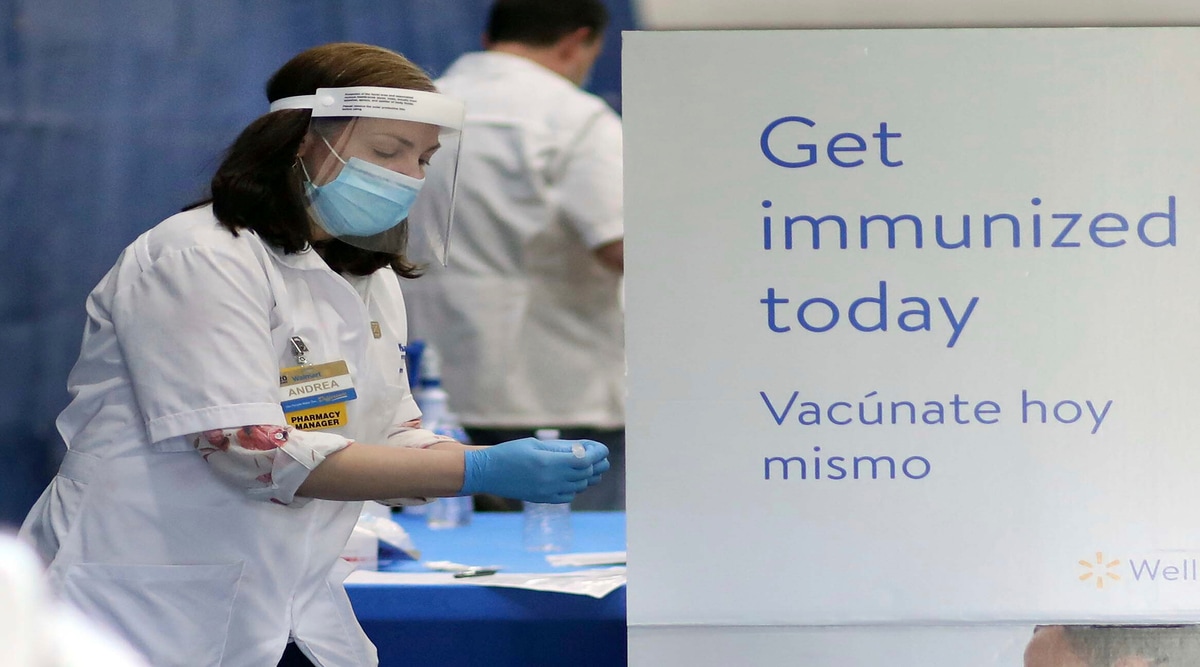 A Walmart pharmacy staff member gets ready to administer a COVID-19 vaccination at Hanover Area High School in Hanover Township, Pa., Tuesday, March 23, 2021, during an inoculation clinic being held there. (Dave Scherbenco/The Citizens' Voice via AP)
A Walmart pharmacy staff member gets ready to administer a COVID-19 vaccination at Hanover Area High School in Hanover Township, Pa., Tuesday, March 23, 2021, during an inoculation clinic being held there. (Dave Scherbenco/The Citizens' Voice via AP) Written by Pam Belluck
In the fall, after Samar Khan came down with a mild case of COVID-19, she expected to recover and return to her previous energetic life in Chicago. After all, she was just 25, and healthy.
But weeks later, she said, “this weird constellation of symptoms began to set in.”
She had blurred vision encircled with strange halos. She had ringing in her ears, and everything began to smell like cigarettes or Lysol. One leg started to tingle, and her hands would tremble while putting on eyeliner.
She also developed “really intense brain fog,” she said. Trying to concentrate on a call for her job in financial services, she felt as if she had just come out of anesthesia. And during a debate about politics with her husband, Zayd Hayani, “I didn’t remember what I was trying to say or what my stance was,” she said.
By the end of the year, Khan was referred to a special clinic for COVID-related neurological symptoms at Northwestern Memorial Hospital in Chicago, which has been evaluating and counseling hundreds of people from across the country who are experiencing similar problems.
Now, the clinic, which sees about 60 new patients a month, in-person and via telemedicine, has published the first study focused on long-term neurological symptoms in people who were never physically sick enough from COVID-19 to need hospitalization, including Khan.
The study of 100 patients from 21 states, published Tuesday in The Annals of Clinical and Translational Neurology, found that 85% of them experienced four or more neurological issues like brain fog, headaches, tingling, muscle pain and dizziness.
“We are seeing people who are really highly, highly functional individuals, used to multitasking all the time and being on top of their game, but, all of a sudden, it’s really a struggle for them,” said Dr. Igor J. Koralnik, the chief of neuro-infectious diseases and global neurology at Northwestern Medicine, who oversees the clinic and is the senior author of the study.
The report, in which the average patient age was 43, underscores the emerging understanding that for many people, long COVID can be worse than their initial bouts with the infection, with a stubborn and complex array of symptoms.
This month, a study that analyzed electronic medical records in California found that nearly a third of the people struggling with long COVID symptoms — like shortness of breath, cough and abdominal pain — did not have any signs of illness in the first 10 days after they tested positive for the coronavirus. Surveys by patient-led groups have also found that many COVID survivors with long-term symptoms were never hospitalized for the disease.
In the Northwestern study, many experienced symptoms that fluctuated or persisted for months. Most improved over time, but there was wide variation.
“Some people after two months are 95% recovered, while some people after nine months are only 10% recovered,” Koralnik said. Five months after contracting the virus, patients estimated, they felt on average only 64% recovered.
Across the country, doctors who are treating people with post-COVID neurological symptoms say the study’s findings echo what they have been seeing.
“We need to take this seriously,” said Dr. Kathleen Bell, chairwoman of the physical medicine and rehabilitation department at the University Texas Southwestern Medical Center, who was not involved in the new study. “We can either let people get worse and the situation gets more complicated, or we can really realize that we have a crisis.”
Bell and Koralnik said many of the symptoms resembled those of people who had concussions or traumatic brain injuries or who had mental fogginess after chemotherapy.
In the case of COVID, Bell said, experts believe that the symptoms are caused by “an inflammatory reaction to the virus” that can affect the brain as well as the rest of the body. And it makes sense that some people experience multiple neurological symptoms simultaneously or in clusters, Bell said, because “there’s only so much real estate in the brain, and there’s a lot of overlap” in regions responsible for different brain functions.
“If you have inflammation disturbances,” she said, “you can very well have cognitive effects and things like emotional effects. It’s really hard to have one neurological problem without having multiple.”
In the Northwestern study, Koralnik said that because coronavirus testing was difficult to obtain early in the pandemic, only half of the participants had tested positive for the coronavirus, but all had the initial physical symptoms of COVID-19. The study found very little difference between those who had tested positive and those who had not. Koralnik said that those who tested negative tended to contact the clinic about a month later in the course of the disease than those who tested positive, possibly because some had spent weeks being evaluated or trying to have their problems addressed by other doctors.
Khan was among the participants who had a negative test for the virus, but she said she later tested positive for coronavirus antibodies, proof that she had been infected.
In the Northwestern study, 43% of the patients had depression before having COVID-19; 16% had previous autoimmune diseases, the same percentage of patients who had previous lung disease or had struggled with insomnia.
Experts cautioned that because the study was relatively small, these preexisting conditions might or might not be representative of all long-term patients.
- The Indian Express website has been rated GREEN for its credibility and trustworthiness by Newsguard, a global service that rates news sources for their journalistic standards.

